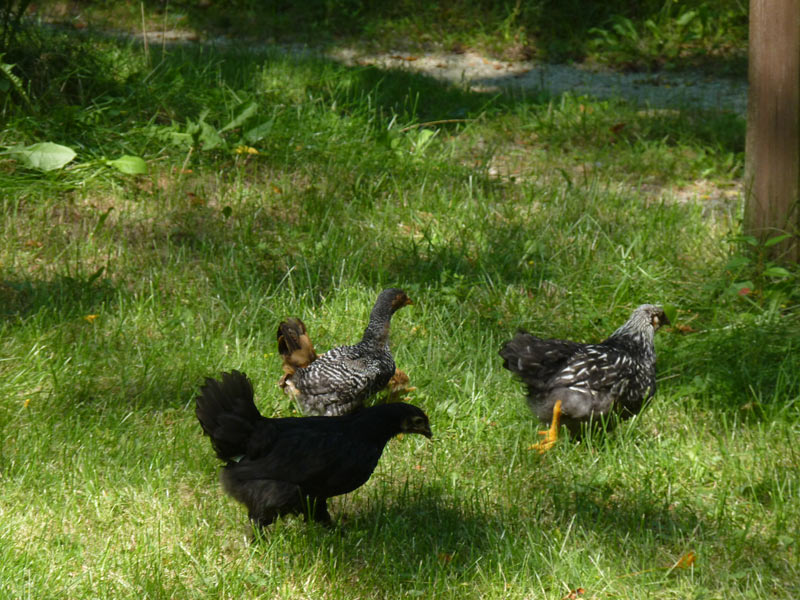Chickens as part of a sustainable system.
Raising chickens has become an activity of growing importance within permaculture/sustainability movements. Most backyard chicken owners raise their birds for eggs, meat, companionship, manure, happiness, and natural pest control. Chickens can form one piece of a larger sustainable system–and I want to stress that when thinking about sustainable transitions, we need to think in systems, not in solitary activity. Its all about how the pieces fit together as a whole and how each piece fits together (for more information on how to think in this way, see Thinking in Systems or Gaia’s Garden).

Chickens can serve a lot of functions in a backyard homestead – their manure is excellent for your garden. You need to compost it down first; it is too nitrogen rich when it first comes out of the chicken and will burn plants if directly applied. I especially enjoy the fact that chickens are like “living composters”; I throw my food scraps to them and they break down that food in a matter of hours, leaving wonderful droppings (and they are wonderful–wait till you see your plants growing in composted chicken manure!)
Chickens also provide excellent pest control. I let my chickens roam free in the garden during a lot of the year to scratch and eat bugs. They eat slugs, squash beetles, potato beetles, earwigs, Japanese beetles, and many more. And what do they do next? Turn it into glorious manure!
Chickens can also be used to turn soil and till the ground. Place them in an area that has been planted with green manure like winter rye, and watch them scratch and peck! In less than a week, they will have mowed down your green manure and you’ll be ready to plant (this is seriously exciting stuff, especially if you work 1600+ square feet of garden by hand like I do!)
Chickens are wonderful companions and bring happiness to your life. I have had chickens throughout my life, and I have always found them to be wonderful companions. Their gentle spirits and calm natures bring peace and tranquility as you watch them go about their chicken-ey business. I have found few things as peaceful as sitting nearby while my peeps scratch in the dirt in my organic garden and take dust baths! Free ranging chickens are so happy with life–give them a few slugs and you’ll watch them experience bliss.
Perhaps the most obvious uses of chickens are for eggs and meat. And certainly, they can provide either in abundance! Our current flock is a laying flock, so we won’t be eating them. But they will faithfully lay about 200 eggs each, per year, once they start laying (which is around 26 weeks old).
The Lessons of the Chicken
Chickens have many lessons for us, if only we heed them. Chickens spend much of their time observing and interacting with nature–they miss very little. Yet their focus isn’t always on survival, a good dust bath, nap in the sun, or simply jumping up on a lap to be given attention is all things that they enjoy. We, too, need to focus not only on our survival, but also remember the simple pleasures in life. Chickens aren’t waste-oriented creatures; everything that they produce is useful, from their droppings to their eggs to their feathers. So too, should we strive to live in harmony with nature and be producers, not just consumers.

The Story of Our Current Flock
We ordered our four baby peeps way back in January of last year to be delivered in mid-July. I had chickens as a child, and I wanted to make sure I got some of the breeds I wanted. Because we wanted layers, I also wanted to have my peeps sexed. You can get peeps locally at your feed supply store, but they aren’t always sexed, and often are quite a bit older (and not always very well socialized). A lot of mail order chicken places ship chickens in lots of 25 or more, which is way too many for the typical homeowner. We could easily have a flock of 25 on our land, but we have no need for so many! So I ordered chickens from mypetchicken.com, who had a wonderful selection of peeps and could ship as few as 3 standard-sized peeps (or 5 bantams). I ended up with 2 standard sized chickens and 2 bantams.
In the days leading up to the peeps’ arrival, I built a cardboard brooder in my garage. This included making an enclosure from some salvaged cardboard boxes, several small food dishes made from paper egg cartons, a small waterer, pine shavings to keep them sanitary, and a heat lamp to keep them warm. There are lots of great directions online for how to build such a brooder and keep your peeps warm and happy. And nearly all of this can be made from repurposed/salvaged materials.

The day before the peeps arrived, I contacted my post office to let them know that they would be coming so that I could go and pick them up. The peeps came in a small hay nest box which kept them warm and safe. Since day-old peeps need to be kept at 95 degrees, the hot days of July were perfect for this!
Its been amazing to watch them grow as the weeks and months go by–they were scared and unsure when they first arrived and huddled together in your hands. Now they are bold, friendly, roaming and free! I’m ending this blog post with some photos week by week so you can get a sense of how fast they grow. They have become a flock of lovely ladies, pecking and scratching, each one with her own personality. They are friendly and active, and have already, in their 11 or so short weeks of life, made such a positive impact on our lives.
Here are some more photos of the peeps as they grow up!













Given all the benefits of chickens, I wonder why many communities ban them? The City of the Village of Clarkston has a very old ordinance banning them from running wild. I have a deed restrictions on my property that will not allow them at all. I also have deed restrictions against certain religions and ethnic races that I’m quite sure cannot be legally enforced. I wonder if past foolishness applies to chickens as well as people? But back to the question of why anyone thought chicens and other livestock should be controlled if not outright forbidden. Clarkston was a farming town with many of the original “downtown” homesteads having animals and crops. Why is it that when we became ‘civilized” the things that allowed us to get there were banned?. Did people just forget how the system works? Was it the noise, the manure, lack of time? An interesting question for a community that prides itself for its history, but bans much of that history from existing.
Its a great question, Cory. Have you read Joel Slatlin’s “Everything I Want to Do is Illegal” book? (http://www.chelseagreen.com/bookstore/item/everything_i_want_to_do_is_illegal/). He has a brief summary of the argument in PDF here: (www.acresusa.com/toolbox/reprints/Salatin_Sept03.pdf). He talks about his experiences as a farmer, from butchering his own livestock to hiring interns to trying to build a house the way he wants. At each point, he encounters a bureaucratic system that privileges big agriculture/big corporations and the status quo rather than small-scale farmers/homesteaders,etc. Its a book worth reading, and speaks to some of what you are talking about!
I think that these battles over livestock, front-yard gardens, etc., have been going on for quite some time! Oak Park being the most recent, and now there is a bit of controversy in Toronto, etc. Even for me, I’ve been having very interesting conversations with my family who visit and my neighbors about my refusal to mow my lawn and instead plant it with wild edibles (many of which are listed as “noxious weeds” and forbidden in the Independence Township regulations!) It seems like educating people, having good conversations, and encouraging reason and civility are first steps forward.
And I’m really surprised that deeds would be able to have such language in them. But somehow it doesn’t surprise me–I heard of such similar things where I grew up as well (in Western PA).
Excellent post, Willow. I think people who grew up in urban and suburban areas in the past 40 years forget that there was once a time when having chickens in the backyard was common — this was true even in the 1950s in the town where I grew up. Thank you for demystifying the process. Your chickens are beautiful birds.
I am an apartment-dweller, but have opportunities to by farm-fresh egss at several farmers markets in town. My city, Annapolis, MD, has been debating the whole chickens-in-the-backyard issue. I stand firmly on the side of allowing resposible urban farmers to raise chickens, so long as they are careful about caring properly for birds and managing their waste for the benefit of the soil.
You bring up a good point about waste. Using the Chicken Tractor method that I use (which I will post on here fairly soon) you don’t really generate any smell. A properly managed chicken coop shouldn’t be smelly.
I think today that people associate chicken coops with stench b/c huge factory/industrial farms pack them in so tight that they are constantly living in their own feces. A free-ranging flock of birds or one that has a tractor or small coop that is cleaned does not have that problem!
I really enjoyed your post. It brought back memories of my “ladies” who used to live with me some years ago. They were rescues from the local battery farm and it took them ages to regain their feathers and also to lose their fear of being outside.
Oh, what a wonderful thing to do, to rescue chickens from a battery farm. I have rescued cats, but never had the opportunity to rescue a chicken! 🙂
Chickens seem a good way to control slugs.
Hey, I have a stained glass order for ‘something chicken-y’… I’d like to use your chickens 😀
Do you have more pictures than what are shown here? I want grown up, as much color as possible (though I can change that of course). I really like the ones where they’re all sitting on the barrel. I think of that as the Gossiping Hens (which is probably what the window will be named.)
and thanks!!!
Meran, I have a LOT of photos of them on Facebook. Those are all the best shots. Did you look there? 🙂